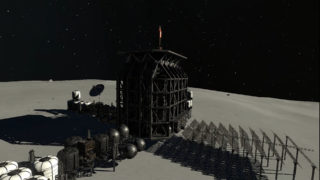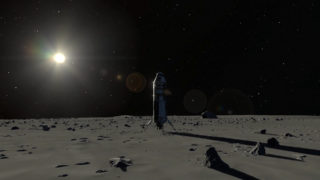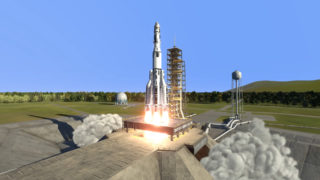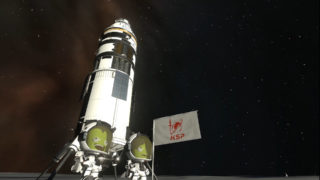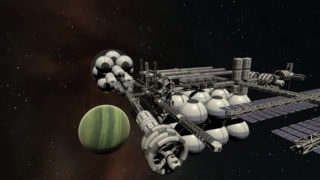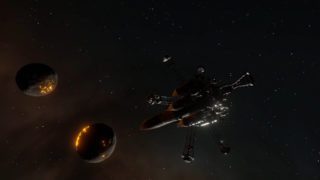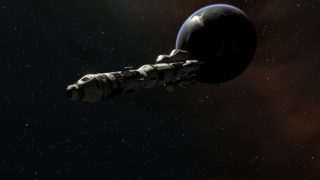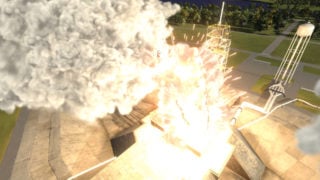An in-depth conversation with the creator of KSP2
Fusion, time warps and many, many failed launches

Interview questions by Kornel Lambert.
Take-Two’s indie publishing label Private Division announced Kerbal Space Program 2 at Gamescom, the sequel to 2011’s popular engineering sim.
KSP 2 will launch in spring 2020 for PC on Steam and other storefronts, and “shortly after” for PlayStation 4 and Xbox One.
The title’s in development at Star Theory Games (formerly Uber Entertainment), an independent studio “comprised of a team of engineers and designers with aerospace specialization.”
VGC saw the game in action in a behind-closed-doors meeting and it appears its creators are well aware of the task at hand, having already worked to implement many of the KSP community’s most requested features.
A technical game requires technical interview questions, so we called in the assistance of VGC technical director – and KSP super fan – Kornel Lambert to extract the most in-depth info yet from creative director Nate Simpson.
Can you give us a bit of background on Star Theory and who is working on KSP2? The original was obviously built by Mexico-based Squad.
The team is north of about 30 people right now and we’re still growing. We were originally Uber Entertainment and then we got tired of being confused with the car sharing company. As a funny side story, they actually asked us permission because we had the name first, and we said yes!
But also because we were reshaping the company around this project anyway, Star Theory felt more resonant. We voted on it as a team. Fundamentally it is a new company because the composition of the team has largely been shaped by the challenge of building this new game.
How are you planning to better support high part counts on vessels compared to the old game, which was a bit notorious for lagging with larger creations?
For the original Kerbal Space Program and this game, rigid body physics calculation is a CPU intensive process and traditionally the higher your part count, the worse your frame rate. So we put a lot of thought in to optimising the way that we’re calculating rigid body physics, working with ideas like basically a LOD system for those physics calculations.
Obviously there will also be some part count threshold beyond which you will start to see impacts to the frame rate, because we’re not going to give you a hard limit. It ultimately comes down to how fast your computer is and how far you’re willing to push it. But we want you to be able to build the things that you’ve seen in the trailer for example, without a noticeable frame rate hit.
There are a lot of other small sub-systems that are in development for optimising that experience, whether it’s the distance of a specific rigid body array from the camera, the size and complexity of the array, the individual pieces within that array… there’s a lot of stuff that taps in to those systems and that’s all under development right now.
I know a lot of people have seen the pre-alpha gameplay footage and mentioned seeing frame rate hits, but I would put an emphasis on pre-alpha: the game is in development. We’re very confident that we have those problems in our sights.
“Internally we’ve had a bet around whether someone in the community will attempt to run an interstellar mission in real-time! It would take years, but if you have an extra computer that you don’t want to use for anything for a while…”
So in short, it will perform a lot better than the original?
Oh… way better. Way better.
How will interstellar travel work in KSP2? Will we get “constant thrust” in time warp this time around?
Absolutely. That’s an astute question, because you couldn’t use time zoom under acceleration in the original game so often if you were building a long burn with a low-thrust engine, to go to a place like Duna or Jool, you would start you burn and then like… go make a sandwich.
With KSP2 we really wanted to maximise the percentage of your time that you’re spending doing fun or creative things and really minimise the amount of waiting. That challenge is a thousand times more important when it comes to interstellar travel, because with interstellar trajectory you’re kind of moving out of the classic ‘coast to your destination’ trajectories of the original game.
We’ve had to overhaul the map view and map system to allow you to plan a continuous acceleration trajectory, and of course we’ve had to add a couple more levels of time zoom because many of these voyages take years and we don’t want you to have to literally sit at your computer for years. Although internally we’ve had a bet around whether someone in the community will attempt to run an interstellar mission in real-time! It would take years, but if you have an extra computer that you don’t want to use for anything for a while…
Are there any plans for interesting Easter Egg locations on planets or in space, for the community to find? The original game had very bland planets, which was somewhat fixed in the Breaking Ground DLC.
All I can say about that is that it’s a big universe and it’s worth exploring. We expect that there will probably be something out there that’s worth finding.
On the planets, I can speak to our overhaul of the terrain system. We definitely wanted to make that a richer experience. Our goal internally has been for no two places where you land to feel identical. We don’t want to see tiling textures, we don’t really like featureless landscapes… These terrains have a certain amount of interacting procedural detail that I think is pretty cool. That’s in addition to a new surface mesh scatter system, so there’s a lot more small scale detail on terrains as well.
Hopefully we want people to be taking screenshots of the weird emergently strange places that they discover, while sharing those locations with other people in the community. It should feel a lot more natural now.
Roughly how many parts can we expect to launch with the game, and are there plans to add more post-release?
I’ll answer this question backwards. The original Kerbal Space Program had a very long tail and it continues to be supported by Squad even after eight years. Our hope is that KSP2 is a similar long-tail product and that we’re continuing to add stuff to the game ten years from now. That would be my ultimate, dream scenario.
We are bringing most, but not all, of the parts from Kerbal Space Program over to the sequel. There are a couple of part types that have been sort of invalidated by new stuff that we’ve put into the game. To give you one example, we’ve overhauled the way engine plates work so that mutli-nozzle engines like the Mammoth are no longer really necessarily, because you can attach four vectors to a 3.75 metre tank and get a similar result. We kind of want people to be able to mix-and-match engines in that way.
I can’t give you a hard number on how many parts beyond that there are. You get a hint at it just by looking at the trailer: pretty much all of the parts that you’re seeing in the late progression involve new core sizes, – there are two new core sizes that have been added to the game – new fuel types, new propulsion types and of course everything on the colonies is completely new.
So depending on how you count it, the part count has really gone a lot higher. But I don’t have a specific number for you.

How will multiplayer mode handle timewarp? Will the sessions be server-based or peer-to-peer?
We have lots of exciting things to talk about around multiplayer at a later date.
Just how “near future” will some of the new engines be? Are we getting VASMIRs, or a Krepstein drive?
Krepstien is a reference to the Epstein drive from The Expanse, which is a torch-ship engine that is like the magic tech of The Expanse, that makes it possible to move from planet-to-planet very, very quickly. There are actually engines in the game that are similar to the Epstein drive because of their torch-ship qualities, because they have that magic combination of high thrust and a high specific impulse.
I’m actually not going to get into the exact mechanisms of those engines. We’ve shown a couple of them in materials that have already been released and nobody has guessed what they are yet. So that’s a fun Easter Egg for the community to hunt down.
The two that the community have absolutely correctly identified from the trailer are the nuclear pulse propulsion, which is Project Orion, which we would totally be using in the real world right now if it wasn’t for the nuclear test ban treaty. That one spits out tiny nuclear bombs that explode against a pressure plate, which is a very Kerbal way to get around. Only people who have very little sense of their own mortality would use an engine like that!
The other one that people have correctly identified is inertial confinement fusion, which is a big, giant engine that you see on the interstellar vehicle that’s leaving space half way through the trailer. But there are some others in there that nobody has identified yet! I’m curious when people will catch on to what else we’re playing around with there.
“I want to shoot for the moon, then we’ll get as far as we get. But there will be radical improvements in the visual presentation across the board.”
What can we expect in terms of graphical improvements? Will there be visible atmospheres this time, for example?
Partly by just creating the game in a more recent version of Unity, we get a lot of the benefits of using physically-based rendering, which includes reflection modes, plus new shaders and materials.
We have a planet shine system now, which means that at night on the surface of Kerbin there’s Mun light and that’s surprisingly beautiful. One problem that a lot of people had with the original game was sometimes when you landed in the dark, you were really in the dark – you couldn’t see anything. Planet shine kind of adds a new dimension and also makes everything prettier. You have a second and sometimes third light source hitting your vehicle because there are multiple moons around.
And then yes, we’re putting a lot of work into improving atmospheres. I personally have a pretty long wishlist for what I want to see here, but It would probably not be smart of me to commit to anything because… I want to shoot for the moon, then we’ll get as far as we get. But there will be radical improvements in the visual presentation across the board.
Any plans for Linux support?
We will have more details on that are at a future date.

What about an Early Access program on Steam?
I don’t know. I’ve not had that question before! As creative director I’m focused on the in-game challenges.
What are the chances of cross-platform multiplater?
There will be a big multiplayer update in the future.
Finally, are there any plans on increasing the DeltaV requirements for missions, in order to make orbital construction meaningful?
The performance characteristics of the existing parts from Kerbal Space Program 1 are the same, and we did that specifically so that existing players won’t be disorientated by the new experience. The way that we’re balancing the capabilities of the new propulsion types is in flux and subject to continued play testing.
It’s a very complex and intertwined set of the decision that we’re now having to make around how all these parts and technologies interact with the larger progression. Like how quickly we expect you to be able to get to certain portions of the game loop. So I can’t give you a specific answer to that, but the masses of the celestial bodies in the Kerbolar system are the same as they were in the original game and their positions are the same.
One new thing that we have now is axial tilt. The planets in the original KSP tend to be aligned perpendicularly to their ecliptic orbit and we are now able to essentially have seasons, because the planets can tilt a little bit. Obviously we don’t want the planets in the Kerbolar system to feel radically different from the original, so we might only be fiddling with that a little bit in terms of that system
But if you’re asking, ‘will there be more exotic DeltaV challenges?’ The answer to that is yes. We’re developing the new celestial bodies with a specific view to making sure that we’re continuing to challenge players as they get deeper into the game.



